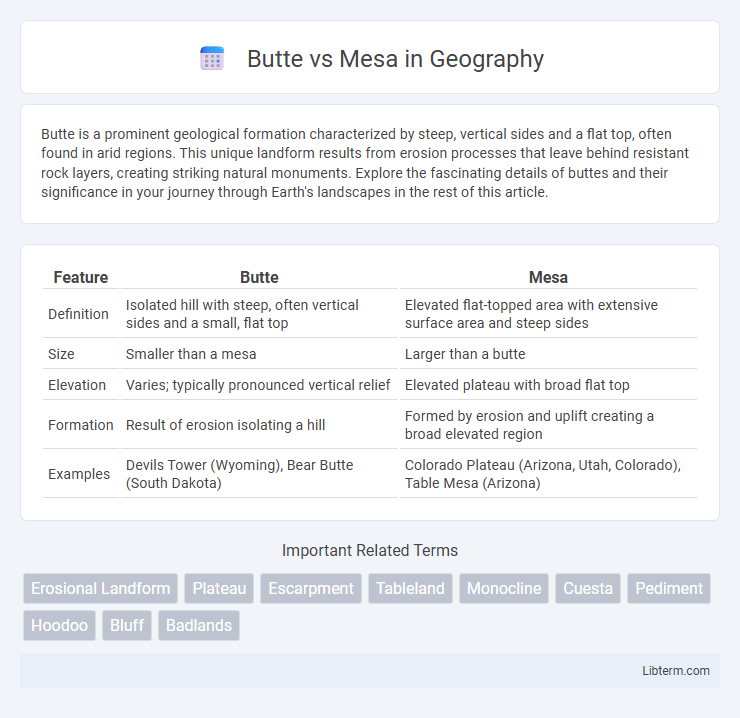Butte is a prominent geological formation characterized by steep, vertical sides and a flat top, often found in arid regions. This unique landform results from erosion processes that leave behind resistant rock layers, creating striking natural monuments. Explore the fascinating details of buttes and their significance in your journey through Earth's landscapes in the rest of this article.
Table of Comparison
| Feature | Butte | Mesa |
|---|---|---|
| Definition | Isolated hill with steep, often vertical sides and a small, flat top | Elevated flat-topped area with extensive surface area and steep sides |
| Size | Smaller than a mesa | Larger than a butte |
| Elevation | Varies; typically pronounced vertical relief | Elevated plateau with broad flat top |
| Formation | Result of erosion isolating a hill | Formed by erosion and uplift creating a broad elevated region |
| Examples | Devils Tower (Wyoming), Bear Butte (South Dakota) | Colorado Plateau (Arizona, Utah, Colorado), Table Mesa (Arizona) |
Introduction to Buttes and Mesas
Buttes and mesas are distinct landforms characterized by flat tops and steep sides, formed through erosion processes in arid regions. Buttes are smaller, isolated hills with steep, often vertical sides, while mesas are larger, table-like plateaus with broad, flat summits. Both features are common in the southwestern United States and serve as prominent geological markers in desert landscapes.
Defining Butte: Characteristics and Formation
A butte is a steep, isolated hill with a flat top and steep, often vertical sides, formed primarily through erosion processes that remove softer rock layers, leaving behind more resistant rock. Characterized by its height, narrow summit, and prominent presence in arid landscapes, buttes differ from mesas by being smaller in surface area but similarly shaped. Geological formation of buttes involves weathering and erosion that isolate these landforms, resulting in their distinctive, tower-like appearance.
Understanding Mesa: Key Features and Origins
A mesa is a flat-topped hill with steep sides, formed through erosion processes that leave a wide, table-like summit. Commonly found in arid landscapes, mesas are characterized by horizontal rock layers that resist weathering, preserving their distinctive plateau shape. These geological formations originate from the gradual wearing away of soft rock beneath a harder, erosion-resistant caprock.
Geological Processes Behind Buttes and Mesas
Buttes and mesas form through differential erosion where harder rock layers resist weathering while surrounding softer layers erode away. Buttes are isolated hills with steep, often vertical sides and a smaller summit area compared to mesas, which are characterized by broad, flat tops and more extensive surface coverage. The geological processes behind these formations include erosion by wind and water, tectonic uplift, and sediment deposition, which together shape their distinct profiles over millions of years.
Visual Differences: Shape and Size Comparison
Buttes are isolated hills with steep, often vertical sides and a small, flat top, typically smaller in size compared to mesas. Mesas have a larger, more extensive flat summit and are broader across, resembling a table-like shape with steep cliffs surrounding the plateau. The visual distinction lies in the mesa's expansive, flat surface area contrasting with the butte's narrower, more condensed top and steeper, more pronounced slopes.
Notable Examples of Buttes Around the World
Monument Valley in the United States showcases iconic buttes like the East and West Mitten Buttes, renowned for their steep, isolated hills with flat tops and vertical cliffs. In Australia, the striking Uluru (Ayers Rock) is often classified as a massive butte due to its prominence and solitary nature rising abruptly from the surrounding desert. Other notable buttes include Castle Butte in Canada and Bear Butte in South Dakota, each exemplifying the distinct geological formation characterized by erosion-resistant rock caps atop steep sides.
Famous Mesas and Their Locations
Famous mesas such as Monument Valley in Arizona and the Mexican Hat Mesa in Utah stand out for their striking flat-topped elevations and steep sides, iconic in the American Southwest landscape. These mesas, formed through erosion processes, serve as significant geological landmarks and popular tourist destinations. Their unique shapes and cultural significance make mesas distinct from buttes, which are typically smaller and more isolated landforms.
Ecological Impact of Buttes and Mesas
Buttes and mesas, as prominent landforms in arid and semi-arid regions, significantly influence local ecosystems by providing unique microhabitats that support diverse plant and animal species adapted to rugged terrain. Their steep rock faces create windbreaks and microclimates that reduce soil erosion and promote moisture retention, which benefits specialized flora such as drought-resistant shrubs and lichens. The ecological impact of these landforms includes serving as refuges for rare wildlife, sustaining biodiversity, and shaping watershed patterns that affect surrounding landscapes.
Cultural and Historical Significance
Buttes and mesas hold distinct cultural and historical significance rooted in indigenous traditions and Western expansion narratives. Buttes often serve as sacred landmarks in Native American cultures, symbolizing spiritual connections and storytelling, while mesas were crucial sites for ancient settlements and agriculture due to their flat tops and defensible positions. Both landforms feature prominently in the mythologies and oral histories of Southwestern tribes, reflecting their enduring roles in cultural identity and heritage preservation.
Butte vs. Mesa: Summary and Key Takeaways
A butte is an isolated hill with steep, often vertical sides and a small, flat top, typically formed by erosion-resistant rock layers. A mesa is larger, with a broader flat top and steeper sides, representing an extensive plateau that has been eroded over time. Both landforms illustrate different stages of erosion in arid environments, with buttes generally being the remnants of mesas.
Butte Infographic

 libterm.com
libterm.com